Metamorphic rocks like slate, quartzite, marble, gneiss, and shists are all important rocks we use at home for construction (dimensional stones, aggregate, fill, etc.), landscaping, paving, retainer walls, and so on. What are metamorphic rocks, how are they formed, and what are the types and examples?
Contents
- What are metamorphic rocks?
- How are metamorphic rocks formed?
- How does it happen?
- 2. What new rocks form?
- Types of metamorphic rocks
- 1. Foliated metamorphic rocks
- 2. Non-foliated metamorphic rocks
- 19 Examples of metamorphic rocks
- 1. Slate
- 2. Phyllite
- 3. Schist
- 4. Soapstone (soaprock or steatite)
- 5. Amphibolite
- 6. Hornfels
- 7. Gneiss
- 8. Marble
- 9. Quartzite
- 10. Anthracite coal
- 11. Skarn or tactites
- 12. Migmatite
- 13. Lapis Lazuli
- 14. Granulite rock
- 15. Serpentinite
- 16. Eclogite
- 17. Mylonite
- 18. Pelitic rocks or metapelites
- 19. Glacier ice
What are metamorphic rocks?
Metamorphic rocks are one of the three rock cycles. The others are igneous and sedimentary rocks. The term ’metamorphic’ comes from two Greek words, meta meaning to change, and morphos means form. So, metamorphic roughly translates to a change of form.
So, metamorphic rocks are rocks formed when igneous, sedimentary, or even existing metamorphic rocks transform their physical appearance and chemical composition properties. This change or transformation (metamorphism) occurs due to intense heat, pressure, mineral-rich hot fluids, or a combination of these factors.
The original non-metamorphosized or parent rocks are known as protoliths. An example is limestone rock. This sedimentary rock forms marble when it undergoes metamorphism.
Lastly, a large part of the earth’s crust has metamorphic rocks. Also, they form about 12% of the land surface.
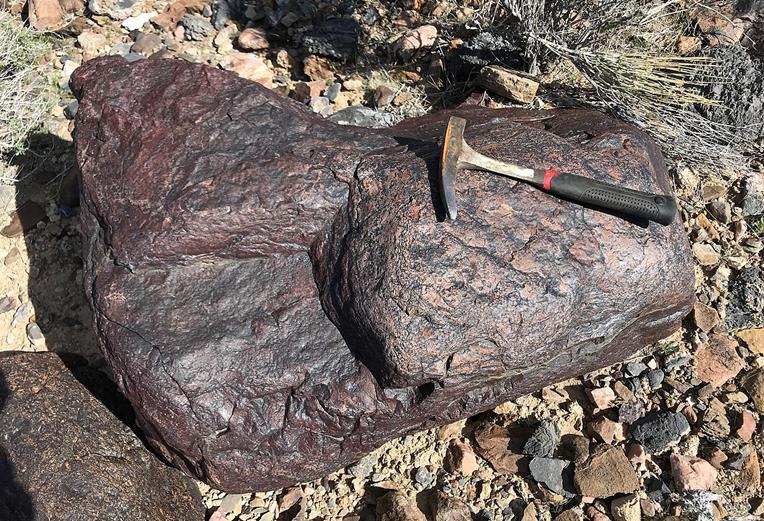
How are metamorphic rocks formed?
Yes, metamorphic rocks form when sedimentary, igneous, or existing metamorphic rocks are subjected to high temperature, pressure, and mineral-rich hot fluids acting alone or more often combined to create a new rock with different mineral composition and texture.
The process occurs deep inside the earth’s crust or where tectonic plates meet where the above conditions prevail, and it is instantaneous or takes millions of years. However, erosion and geological uplift then expose the metamorphic rocks formed.
Also, metamorphism usually occurs between diagenesis and melting. Remember, diagenesis forms sedimentary rock types, and melting results in igneous rocks. It occurs:
- At temperatures more than 150 to 200 °C (300 to 400 °F)
- At pressure above 100 megapascals (1,000 bar)
- Without melting parent rock, this would form magma and change the rock cycle to igneous rocks.
How does it happen?
Are you wondering how the whole process of metamorphism happens? Worry not. We will simplify it for you. Metamorphism involves recrystallization, phase change, neocrystallization, or plastic deformation. Here is what each means:
- Recrystallization – Pressure, and heat result in a change of grain size and its orientation, i.e., reorganization. It occurs when ions and atoms in parent rocks migrate. For instance, small calcite mineral in limestone or chalk recrystallizes to form large marble mineral and quartz sandstone to quartzite.
- Phase change – This process creates a new mineral with the same chemical composition as the parent rock. For instance, kyanite, andalusite, and sillimanite minerals all have the formula Al2SiO5. However, temperature and or pressure increase will transform from kyanite to sillimanite.
- Neocrystallization – It forms new mineral crystals than the protolith and occurs via chemical reactions.
- Plastic deformation – occurs when pressure is applied to rocks to make them bend or shear without breaking.
2. What new rocks form?
The new metamorphic rock formed may have:
- The same mineral composition but different size, shape, or orientation
- A new mineral with the same composition as the parent rock.
- A new mineral with different chemical composition
In most cases, only rearrangement and new minerals form without altering the bulk composition. However, advanced stages of metamorphism do result in completely different mineral compositions and textures, making it hard to know which protolith was involved.
A complete change in composition involves a chemical reaction between the various rock constituent or hot fluids.
Remember, mineral-rich hot fluids or vapors may have various minerals except for water and carbon dioxide. Some minerals include iron, sodium, potassium, calcium, aluminum, and magnesium. These fluids can get into rock pores dissolving some minerals and taking them out or recrystallizing them inside the rock. These actions will change rock composition.
Finally, different forms of metamorphism form these rocks, common ones being contact, regional, and dynamic.
Types of metamorphic rocks
There are two major types of metamorphic rocks, foliated and non-foliated. However, you can also classify these rocks based on mineral assemblage, texture, protolith (parent rock), and bulk chemical composition of the rock. We intend to talk about foliated and non-foliated when looking at types.
1. Foliated metamorphic rocks
Foliated metamorphic rocks are layered, striped, or banded or metamorphic rocks with a sheet-like or platy parallel structure. These repetitive layers can be from a few millimeters to several meters thick.
Foliated metamorphic rocks form when there is unequal pressure. Of course, other factors like intense all play a role. The direction with the greatest pressure will reorient (flatted and elongated) minerals, forming parallel layers or sheet-like. These layers will be perpendicular to the direction of the force.
Examples of foliated metamorphic rocks are slate, phyllite, gneiss, schist, and migmatite. Most have sheety minerals like chlorites and mica.
2. Non-foliated metamorphic rocks
Non-foliated metamorphic rocks don’t have sheet-like or platy structures, i.e., they don’t have elongated or flatted minerals. The minerals are irregular, and grains don’t align during formation.
These rocks form under high temperature and relatively lower pressure coming from all directions, i.e., confining. The original mineral may recrystallize to larger ones, and atoms pack tightly (increase in density), increases. However, minerals don’t elongate or flatten. For this reason, they will not have a layered or banded appearance.
Examples of non-foliated metamorphic rocks are marble, quartzite, soapstone, hornfels, amphibolite, and skarn.
19 Examples of metamorphic rocks
With all we have talked about metamorphic rocks, it is time to go to the various examples and say a thing or two.
1. Slate
Slate is a foliated, fine-grained metamorphic rock formed from low-grade regional metamorphism of mudstone or shale and rarely volcanic ash. It has mainly clay minerals or micas, depending on the extent to which the change occurs.
Slate is a light to dark gray hard, brittle, and durable rock. However, it may be black, red, green, black, cyan, buff, brown, purple, etc. Color depends on the content of iron, organic matter, and other impurities.

Some of the uses of slate are making roofing and flooring tiles, façade cladding, outdoor pavers, decorative aggregate, or as a dimensional stone. Other applications, including historical ones, are making countertops, tables, cemetery markers, electrical insulators, whetstones, chalkboards, etc.
2. Phyllite
Phyllite is a foliated, metamorphic rock with mainly fine-grained mica flakes or sheets at a preferred parallel orientation. This mica gives it a silvery non-metallic appearance and a reflective sheen.
Phyllite forms from low-grade regional metamorphism that is above that of slate formation. It has mainly fine-grained mica, quartz, feldspar, or chlorite and the parent rocks are slate, shale, mudstones, or pelite.
The color of phyllite rock ranges from gray to black to greenish and non-metallic, silvery appearance. However, weathering may make it appear brown or tan.
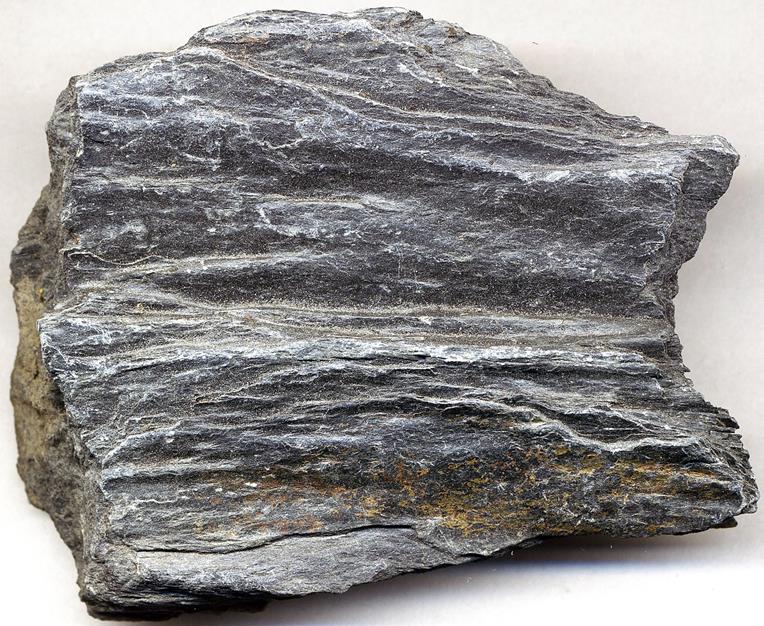
Lastly, phyllite doesn’t have many uses since it’s not hard enough. However, occasionally it may make pavers, sidewalk stones, or be used for landscaping purposes.
3. Schist
Schist is a medium-grained (visible by the naked eye) metamorphic rock with platy or flaky minerals sheets that show a schistosity mode of foliation. It has mainly mica minerals with larger crystals, like muscovite, chlorite, or biotite. However, it may also have quartz or feldspar in the parent rock.
Schist rock at a higher temperature, pressure, and chemical activity than slate or phyllite, i.e., moderate-grade metamorphism. Its parent rocks are shale, mudstone, or igneous rock. Examples are blueschist and greenschist.

The color of the schist varies, but you will notice a shiny, lighter, and darker band. And since it is not very hard and has platy minerals, it doesn’t have many uses in construction or making roads. However, it can decorate walls or gardens and sometimes work as pavers. Also, it makes sculptures and serves as a host rock for many gemstones.
4. Soapstone (soaprock or steatite)
Soapstone is a soft, talc-rich (hydrated magnesium silicate) metamorphic rock with a soapy feel. However, it has other minerals like micas, carbonates, amphiboles, chlorite, pyroxene, etc.
Soapstone may be gray, green, bluish, black, or brown and shows schistosity. It resists acids, bases, and heat. Also, it is a nonabsorbent, non-porous, poor conductor of heat, and its specific heat capacity is high.

Soapstone has many uses, not just making sculptures or carving. These uses include a kitchen or lab countertops, sinks, facing stones, cold stones, walls, and floor tiles. Also, it makes electric panels, woodstoves, cookware, marking pencils, molds for metal casts, and marks cemetery.
5. Amphibolite
Amphibolite is a coarse-grained metamorphic rock composed of primarily brown, black, or green amphibole minerals (hornblende and actinolite) and some feldspar and plagioclase. However, it will also have small amounts of biotite, garnet, epidote, kyanite, calcite, magnetite, etc.
Amphibolite rocks are weakly-foliated and form via regional metamorphism. Parent rocks are mainly mafic igneous (basalt, gabbro) and some sedimentary rocks high in clay minerals (marl or greywacke).
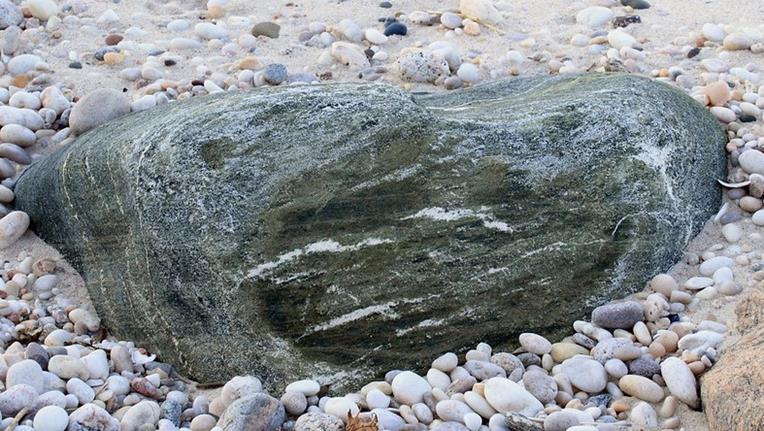
Uses of amphibolite include making ballast and aggregate for roads and highway construction. Also, it makes a good dimensional stone, being harder than limestone. More uses, especially for high-quality amphibolite rock, are floor tiles, indoor panels, facing stones, countertops, etc.
6. Hornfels
Hornfels is a group of fine-grained metamorphic rocks formed when hot ingenious mass or lava bakes, hardness or transforms parent rocks. So, their formation is by contact metamorphisms, and pressure plays a small role.
Depending on the parent rocks, geologists classify hornfels into these types:
- Pelitic hornfels - from shale, mudstone, or clay-rich parent rocks
- Carbonate hornfels- from limestone, marble or dolostone or
- Mafic hornfels -from basalts, diabase, gabbro, rhyolite, andesites, or other mafic igneous rocks.
They can even form from schist and gneiss, which are metamorphic rocks.
Similarly, hardness and other properties depend on the parent rocks. Some may be platy or elongated without preferred orientation and others banded. Also, colors will vary, but most are black, brown, reddish, grayish, or greenish.
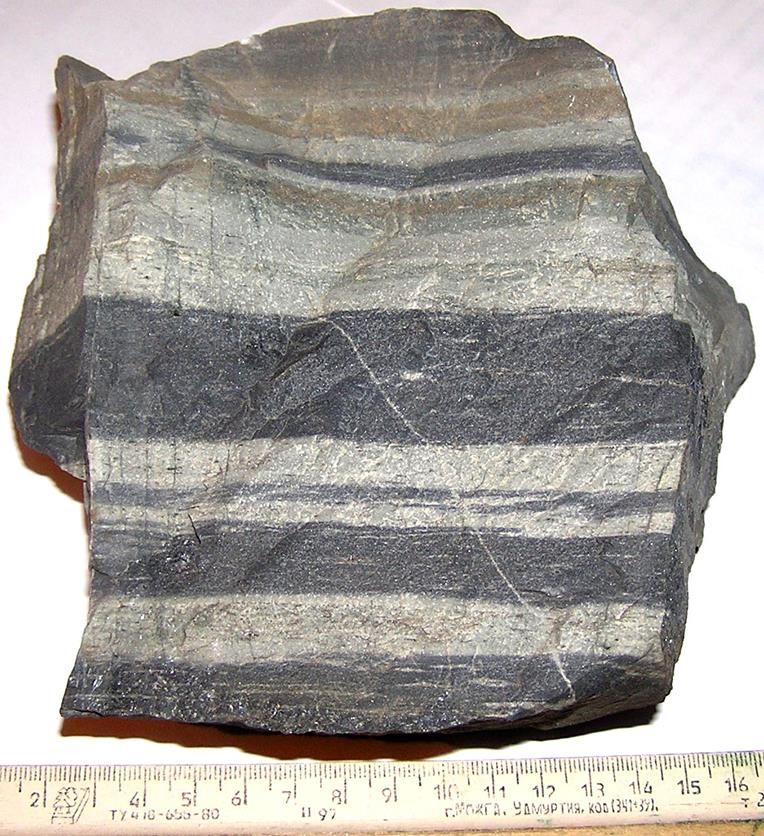
Popular uses of hornfels are construction and beautifying buildings. Hard, lovely-looking hornfels will make interior floors or serve as paving, facing, curbing, or decorating (landscaping) stone. Also, they can make road aggregates, among other uses.
7. Gneiss
Gneiss is a foliated (has light and dark banded), medium to coarse grain, high-grade metamorphic rock without a cleavage plane. It forms when igneous, sedimentary, or even metamorphic rocks like slate, phyllite, or schists are subjected to extremely high pressure and temperature (above schists).
The name doesn’t refer to chemical composition. So, gneiss rocks have different mineral compositions. And usually, quartz and feldspar form lighter bands, while mafic minerals like biotite, pyroxene, and amphibole form a darker band. However, they may have other minerals too. It all depends on the parent rock.
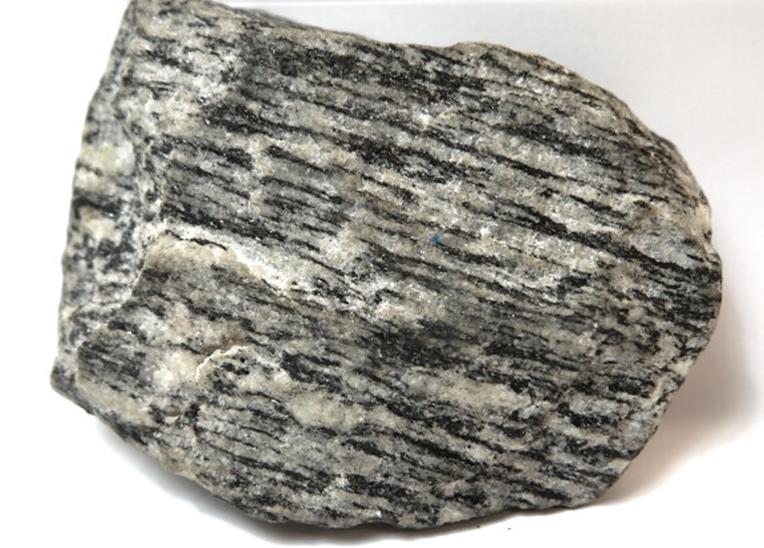
Since gneiss doesn’t split along a certain plane, it can make aggregate and ballast for road or construction. Hard and durable ones are used in building as dimensional stone, paving, curbing, or landscaping.
On the other hand, beautiful and polishable gneiss stones may also make floor tiles, window sills, countertops, stair treads, or monuments in commentaries.
8. Marble
Marble is a non-foliated, medium to coarse-grained metamorphic rock formed from limestone. However, in trade, it may mean any stone that you can polish.
Marble forms when limestone is subjected to high pressure and heat. These conditions make calcite, the primary mineral, recrystallize to form marble with interlocking calcite crystals. However, marble also has other minerals besides calcite like micas, pyrite, quartz, graphite, and mineral oxides.
Pure marble is often white. But the prescience of impurities may make it pale gray, brown, pink, green, yellow, blue, or black.
Crushed marble makes roads, foundations of builds, or railroad beds. Also, it can make paving stones, flooring, dimensional stones, sculptures, monuments, sinks, countertops, and cemetery markers. More uses are in paper and paint industries, soil treatments, neutralizing acids, etc.

9. Quartzite
Quartz is a non-foliated, medium grain metamorphic rock formed when quartz sandstone or quartz-rich chert. High temperature, heat, and chemical alteration make quartz recrystallize to form a granular, denser, and harder rock – quartzite.
Pure quartzite is white to off-white or gray. However, it can be yellow, pink, purple, orange, brown, or bluish due to impurities.
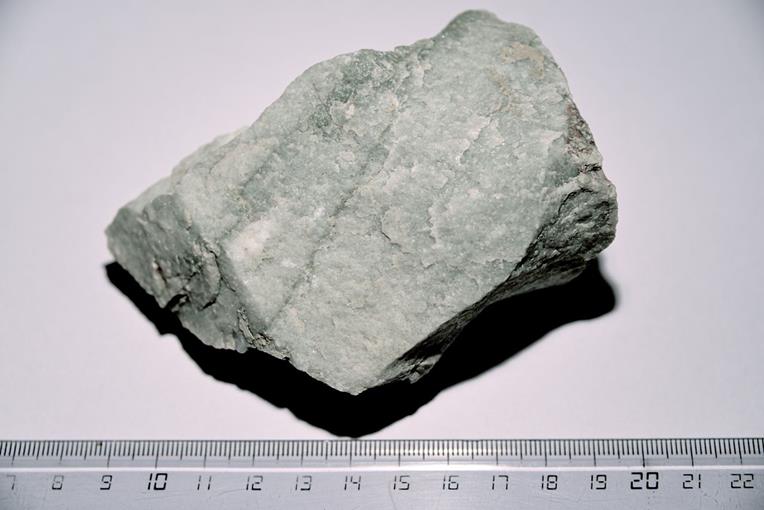
Quartzite is a hard, durable, and chemical-resistant rock making it perfect for floor tiles, stairsteps, kitchen countertops, and wall cladding. Also, it makes durable crushed stones for construction, and if pure, it makes silicon, silica, silicon carbide, or ferrosilicon.
Did you know quartzite was historically used to make tools? However, it was less preferred to flint or chert.
10. Anthracite coal
Coal is a combustible sedimentary rock. It forms when plant remains to accumulate and are preserved in a swampy place. However, anthracite coal (black or hard coal) is a compact and hard low-grade metamorphic rock.

Of course, anthracite is the highest coal rank with 86-87% carbon. Also, it has fewer impurities and is energy-dense. Uses of anthracite include as a fuel for power generation and domestic use.
11. Skarn or tactites
Skarns are hard, coarse-grained, non-foliated metamorphic rocks formed when chemically active hot fluids mineral composition of parent rocks. This alteration process is known as metasomatism. The name skarn refers to a way of alteration and does not reference the mineral or chemical composition of rocks formed.
A common way by this skarns form is when magma intrudes native carbonate rocks like limestone, marble, or dolostone. The heat from magma and chemical active hot fluids will alter this native or country rock. However, they may form in different ways.
There are many types of skarns, named by the economically valuable mineral it has. Examples are Cold, iron, tungsten, copper, zinc, molybdenum, and tin skarns.

Some of the uses of skarns are a source of valuable metals, like gold, tungsten, iron, copper, molybdenum, zinc, tin, etc. Some may also contain gemstones like ruby, garnet, or sapphire. Also, skarns may serve as a flux in steel production or building, facing, decorative, and paving stones.
12. Migmatite
Migmatite is medium to high-grade mixed metamorphic rock with alternating light and dark bands. It forms from the partial melting of the parent rock. This melting results in a light band with igneous properties and dark with metamorphic properties.
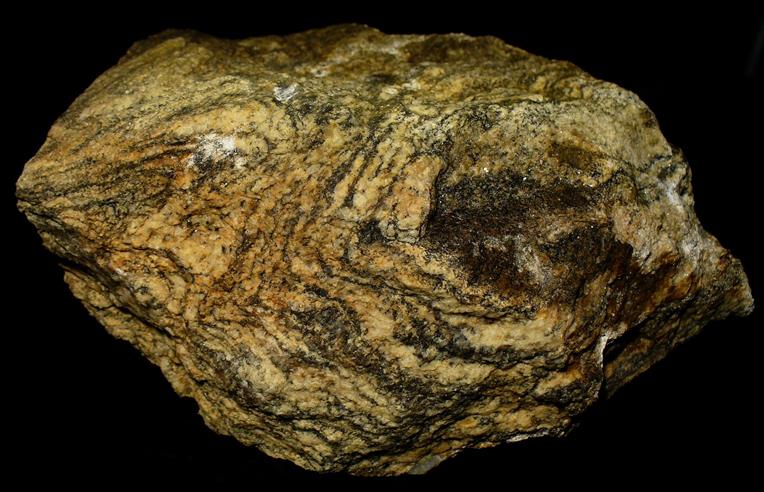
Some of the uses of migmatite are facing and building stone. However, you can polish some for ornamental purposes.
13. Lapis Lazuli
Lapis Lazuli is a deep-blue colored metamorphic rock. It has mainly lazurite, a blue mineral. However, it may have calcite, pyrite, sodalite, and other minerals.
This rock forms by contact or hydrothermal metamorphism, especially at sites of igneous intrudes marble or limestone.
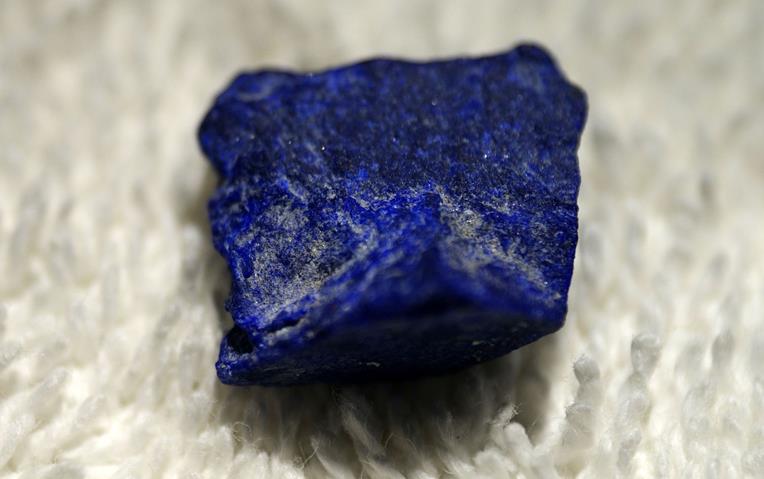
Uses of Lapis Lazuli include making jewelry, carvings, statues, vase, ornaments, boxes, or mosaics. Also, people have used it as a gemstone, paint pigment, beads, and interior finishings. However, it is not a gemstone but a rock.
14. Granulite rock
Granulite is medium to coarse-grained, high-grade massive metamorphic rock that forms at granulite facies. It has a granoblastic texture and is made of mainly quartz + felspar or quartz + pyroxene and varying amounts of garnets. However, it doesn’t have muscovite and forms under high temperature and medium pressure.
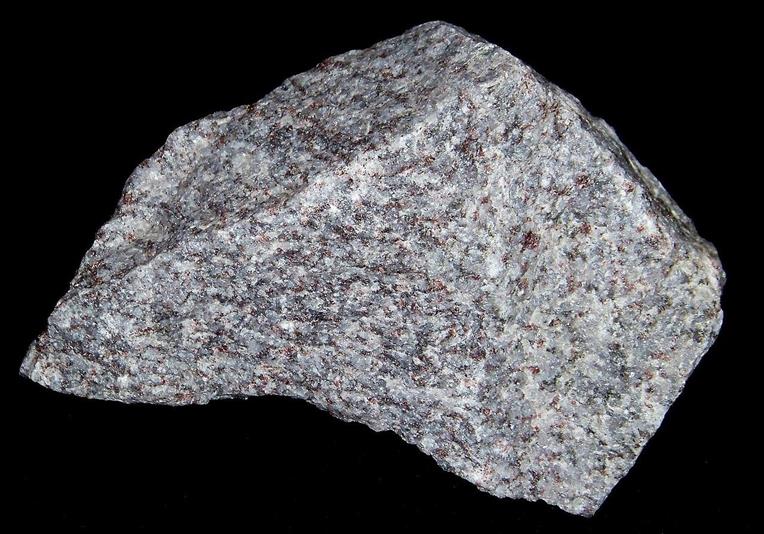
Granulite is a non-banded, almost black rock with small ret spots (from garnet). However, brown, gray, greenish, whitish, and other colors can be brown. This hard rock has many uses, especially in making countertops and decorative aggregate or used as a curbing, facing, paving, and building stone.
15. Serpentinite
Serpentinite is a greasy, scaly-looking, and slippery-feeling metamorphic rock with serpentine group minerals. Examples of the minerals in the serpentine group are lizardite, antigorite, and chrysotile.
These rocks are usually layered or banded. They form when igneous ultramafic rocks are altered by hydration and metamorphism at low temperatures. These rocks are rich in pyroxene and olivine, which forms pyroxenite or peridotite at different ratios.
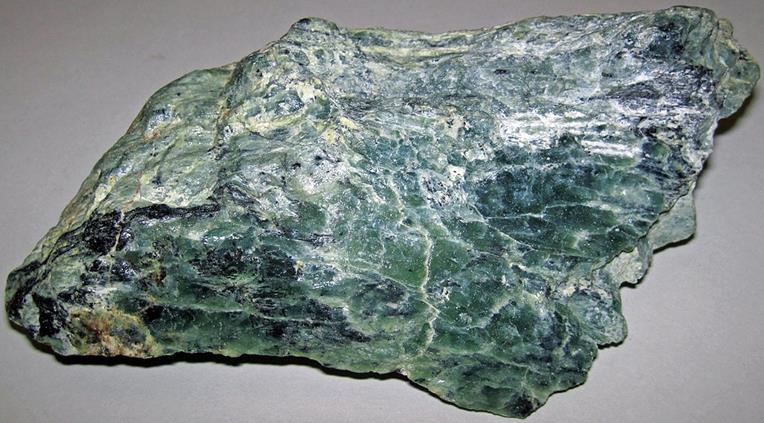
Serpentinites are attractive rocks with brownish, greenish, or spotted minerals, making them ornamental stones and gemstones. Other uses are carving, sequestering carbon dioxide from the air, and in a nuclear reactor as neutron shields.
16. Eclogite
Eclogite is a dense, non-foliated, coarse-grained metamorphic rock made of omphacite (sodium-rich pyroxene), almandite, and pyrope (garnets rich in magnesium). It has other minerals in smaller amounts, such as quartz, rutile, and kyanite but doesn’t have plagioclase. So, composition-wise, it resembles basalt.
This rock is greenish to pink-reddish and may have whitish minerals. It forms from subjecting mafic-rich volcanic or metamorphic rocks to extremely high temperatures and moderate to high pressure.

Uses of eclogite stones include paving and walkways, landscaping, decorative aggregate, and interior decoration.
17. Mylonite
Mylonite is a foliated (banded or layered) compact, dense, fine-grained metamorphic rock. It forms when parent rocks are pulverized, and then minerals present are dynamically recrystallized. They form along shear zones deep within the earth’s crust.
These rocks form from different parent rocks, especially those high in quartz, calcite, sericite, dolomite, feldspar, and chlorite. Examples are sandstone, granite, diorite, marble, dolostone, limestone, and granodiorite. So, mylonite doesn’t represent rocks of a certain chemical composition but rather texture and appearance.
What about colors? Mylonite colors are often black to grayish but can be other colors, depending on the parent rocks.

Uses of mylonite rocks include construction (building or facing stones), making road aggregate, and milestones. Also, you can use them for landscaping, curbing, and paving stones or making artifacts and monuments.
18. Pelitic rocks or metapelites
Metapelite or pelitic rocks is a group of foliated metamorphic rocks formed from fine-grained, clay-rich sedimentary rocks like mudstones or shale, i.e., pelite rocks. They can undergo low, moderate, or high-grade metamorphism to form slates, phyllites, schists, or gneisses.
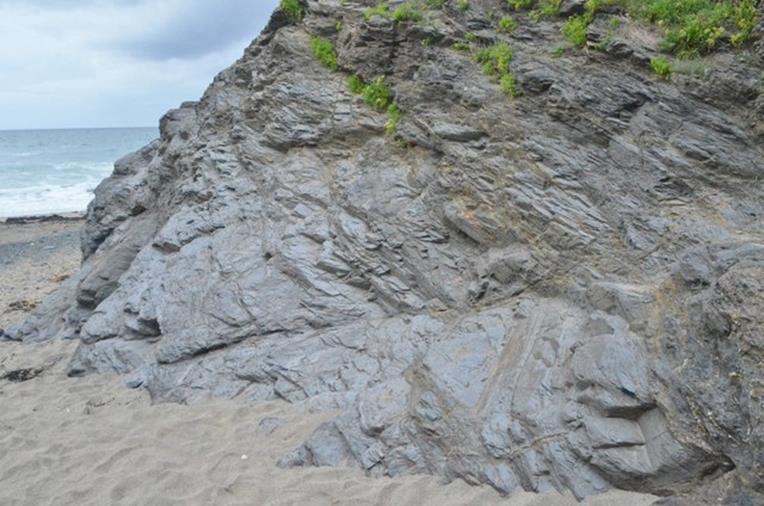
19. Glacier ice
While it may seem bizarre, a glacier is a mono-mineral rock formed by the metamorphosis of snowflakes to form glacier ice crystals.


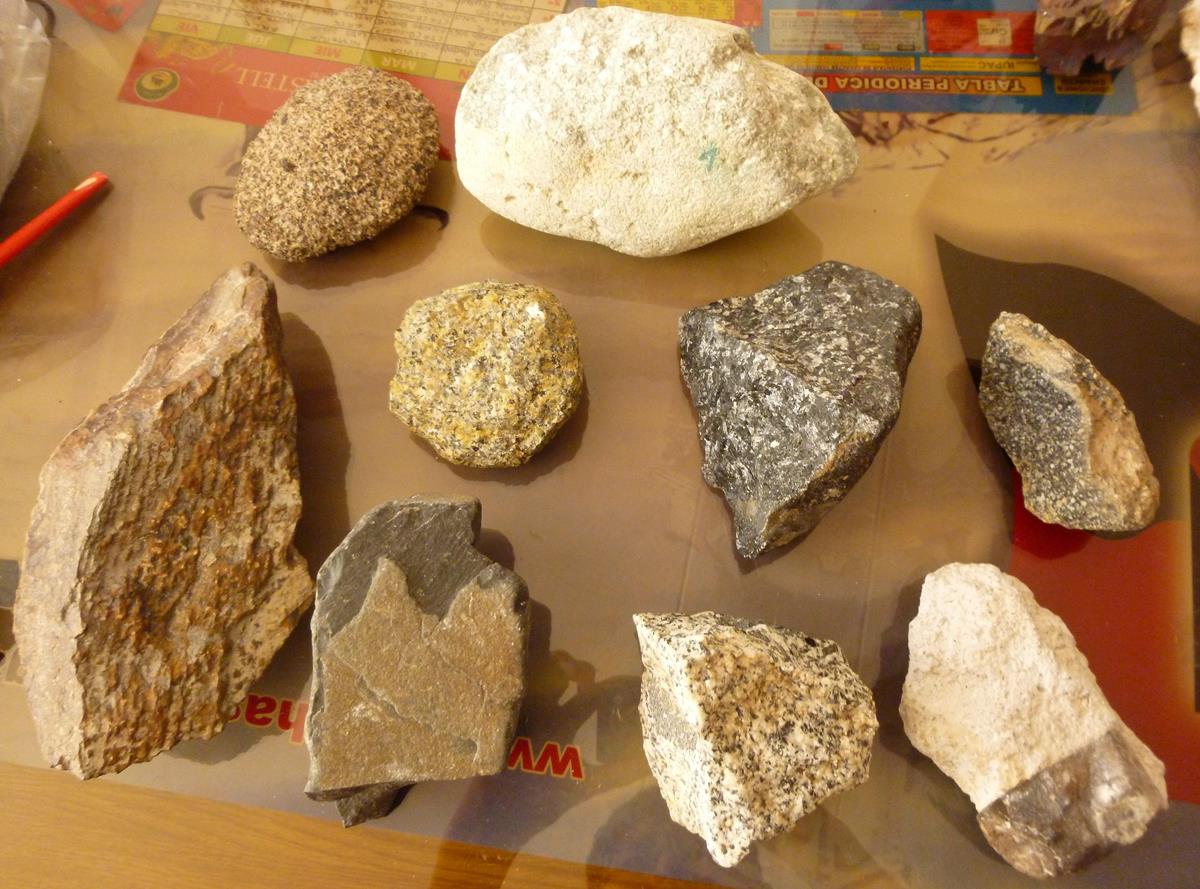
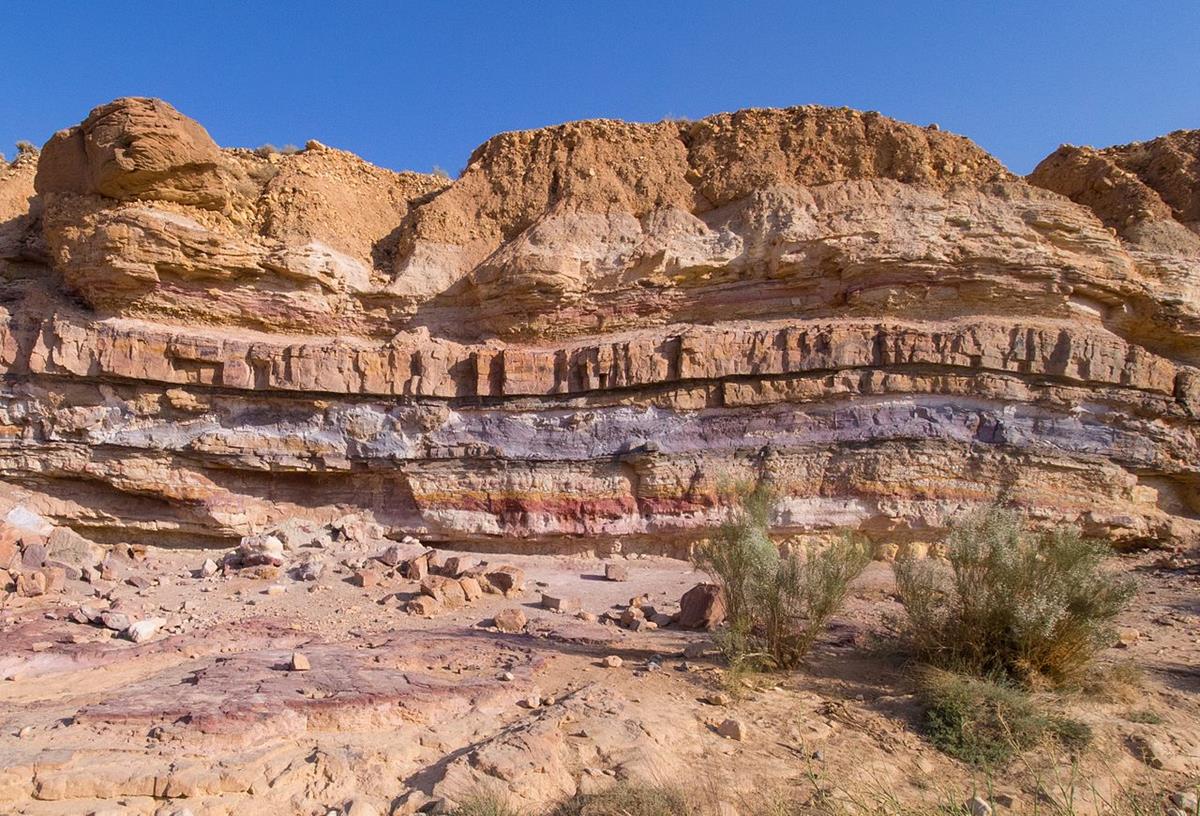
Leave a Reply